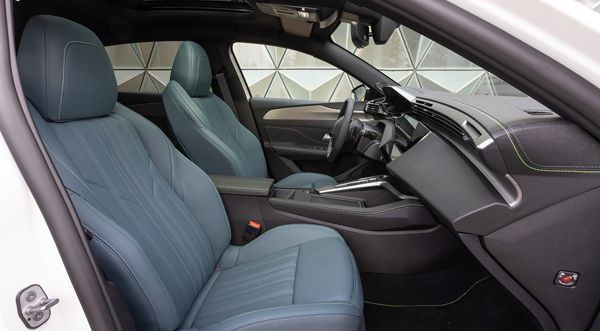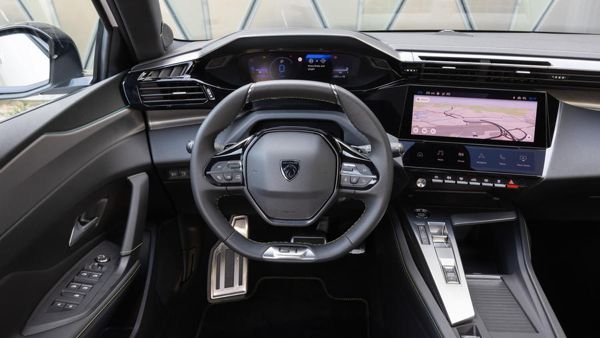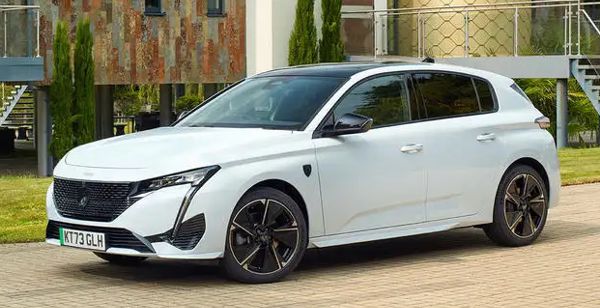Published
on 8
Oct 2021
|
All rights reserved.
|
|
|

|
|
New
308 has lifted the game on styling massively.
|
|
Since Peugeot froze its
model designation to "08", this is the third generation 308. It
continues to ride on the highly flexible EMP2 platform, but development
focuses on a more desirable packaging and the introduction of plug-in
hybrid powertrains.
The last 308 was reinvented as a near-premium car in the mold of
Volkswagen Golf. On the build quality front, its mission was
accomplished. However, in terms of desirability, it lagged a long way
behind Golf. While the i-Cockpit interior looked radical, the contrary
can be said to its exterior styling – boxy, characterless and boring.
This time, Peugeot has really lifted its game. Following the
ground-breaking 208, its bigger brother shares the same stylish genes.
The fascia sports a large grille whose dotted elements with varying
width create a 3-dimensional look. I would prefer the old lion logo
instead of the new Peugeot shield badge, but the same shield badge
doubled on the body side, as in Ferrari, is a welcomed decoration. The
blade-like LED extensions of headlights might look like scars on its
face but also give it a stronger character. Meanwhile, the sculpted
surfaces on its clamshell bonnet deliver a stronger sense of
quality. At the back, it follows the 208 to adopt a thicker, triangular
C-pillar. Overall, the new car has more curves, a more complex shape
and more interesting styling features. It is one of prettiest cars in
the family hatchback class.

|
|
PHEV
is one of the focuses of development.
|
|
Despite the radically new look, the 308 continues to ride on the
existing EMP2 platform. EMP2 is highly flexible. It accommodates cars
as large as Peugeot 508 or even (Citroen) DS9, but the 308 rests on its
smallest end. It measures 4367mm in length, 1852mm in width and runs a
2675mm wheelbase, exceeding the old car by 114mm, 48mm and 55mm,
respectively. It is considerably larger than Golf, too, if not Ford
Focus, Honda Civic or Skoda Octavia. Unlike these rivals, Peugeot
equips its family hatch with only torsion-beam rear suspension. You
can’t argue against that, as the famous 306 GTI proved that independent
rear axle is not a must for great-handling cars. EMP2 offers multi-link
option, of course, as on the larger 508 and DS9, but Peugeot considered
the cost and weight benefits of a simple torsion beam is more important
to a smaller car. If you can save a few hundred dollars from
suspension, why not spend the same amount on upgrading the interior,
safety equipment, infotainment or help relieving the pain of the very
costly plug-in hybrid powertrain?
That compatibility with PHEV tech does bring some compromises in
packaging efficiency though. Judging from the exterior dimensions, you
might expect generous space for rear passenger’s head and legs. Yes, it
does provide more rear legroom than before, but still relatively tight
by class standard. If a six-footer sits behind a driver of the same
size, he will find kneeroom in short supply. Rear headroom is also a
bit tight for six-footers, as Peugeot has lowered the roof by 16mm and
made it curvier. The fact that the inverter of hybrid powertrain sits
under the rear cushion beside the fuel tank prevents the rear seat from
mounted lower.

|
|
Much larger
exterior does not yield a much larger interior, but quality is high.
|
|
Meanwhile, luggage capacity has shrunk from the 470 to 412 liters,
although it is still more than Golf and Focus. Not so the PHEV models,
which drops further to 361 liters, thanks to the installment of 12.4kWh
lithium battery. The 308 is not a good model for space efficiency.
If you need to carry a lot of luggage or bikes, there is still a
solution: SW. The station wagon body is not just a 308 with extended
rear end, but it gets also a wheelbase extension of 57mm. Consequently,
the load bay is huge. It offers 608 liters or 1634 liters with rear
seats folded. Moreover, the SW sacrifices none of the style of the
hatchback.
As expected, the layered dashboard design called “i-Cockpit” is
avantgarde. It places the instrument pod above the ultra-small
flat-top-and-bottom steering wheel. This makes the Peugeot cabin look
like no others. On the downside, shorter drivers will find it difficult
to read the instrument, unless they sit up or lower the steering wheel
to uncomfortable position. Apart from style, this cockpit sells on
build quality. Most surfaces are soft plastics or padding. Piano-key
switches, digital instrument, voice control and a responsive and
customizable touchscreen infotainment system add to an upmarket
perception. 3D effect instrument is gimmicky though.

|
|
i-Cockpit still
splits opinions
|
|
The powertrain lineup of PSA is very simple. You get either a 1.2-liter
Puretech 3-cylinder turbo, 1.6-liter four-cylinder turbo or 1.5HDi
turbo diesel. The 3-cylinder petrol is expected to be the choice of
majority. It delivers 130 horsepower in the 308,
good for 0-60 mph in about 9 seconds no matter paired with 6-speed
manual gearbox or Aisin-licensed 8-speed automatic. Apart from a bit
noisy under heavy throttle, this small engine is highly competent.
You cannot order the 1.6-liter four-cylinder alone. These days even a
1.6-liter engine is considered too polluting, failing to meet fleet CO2
emission target, so it must be bundled with plug-in hybrid tech. The
308 offers not one but two PHEV options. Both employ the same
electrical propulsion system consisting of the aforementioned 12.4kWh
battery and a 110-horsepower electric motor which sits beside the
engine and drives the front axle. They differ in only petrol engine,
tuned to produce either 150hp or 180hp. Combined output is 180hp and
220hp, respectively, while maximum torque is the same at 265 lbft. They
are good for an electric range of 37 miles (60km), long enough for most
commutes. The plug-in capability drags down WLTP emission to just 25
g/km. Mind you, WLTP assumes you drive a fully charged car in every
trip and consume all electricity before switching on the engine, an
assumption that is not only unrealistic but also puts plug-in hybrid
cars in an unfair advantage. Moreover, it counts only tailpipe
emission,
ignoring the emission produced from electricity generation. Anyway, the
rules are written like that. PSA just uses the rules better than
anybody else.

|
|
Refined and
good to drive. PHEV is not as bulky as you would expect.
|
|
Among the 2 PHEV models, the lower power one is expected to be more
popular by far. Although it carries 310kg more than the 1.2-liter
petrol, the
extra 50 horsepower and far superior low-down torque enables it to
sprint from rest to 60 mph in just over 7 seconds. Moreover, in battery
mode it delivers the same quietness as a typical EV. The integration of
electric and ICE power is also expertly done, with minimal noise and
vibration when the petrol engine intervenes. Strong refinement is one
of the key reasons to buy it. The 220hp model is naturally quicker, but
the sensation is not much superior to the 180hp model, because the
instant torque offered by electric motor is just the same. Meanwhile,
carrying over 1600kg, it is not exactly a replacement to GTi. Maybe the
upcoming PSE model with additional rear motor could, but that would be
another story.
The 308 is generally a refined car. It cruises quietly on motorway,
with minimal wind, tire, suspension and engine noises penetrated into
the cabin. If you can avoid the largest 18-inch wheels, it rides
smoothly, too, soaking up bumps and potholes with ease, if not
ultimately as comfy as Ford Focus or Skoda Octavia. As for handling, it
is not as sharp or entertaining as Ford or Mazda 3, but still pretty
good. The steering is responsive, accurate and loaded with decent
feedback, if the weighting is too light for keener drivers. It is
willing to turn into corners, grips well and displays good stability at
higher speeds. More surprisingly, the substantial weight of the PHEV
models does not make it feel bulky or reluctant, although the lighter
1.2-liter model does feel a little more agile. Only when you push it
very hard in corner will find it struggles to maintain poise and
roadholding, and this puts it behind Seat Leon.
Overall, the 308 is a rounded and quite desirable family hatch.
Stylish, high perceived quality, refined and decent to steer. If you
can stand with its slightly cramped rear seat and the lack of mid-range
powertrain – there is a huge gap between the 130hp 1.2 and 180hp PHEV
no matter in power or price – it could be a smart choice.
|
Verdict:     |
Published
on 13
Dec 2023
|
All rights reserved.
|
|
e-308
|
|

|
|
Premium
hatchback, mediocre EV performance.
|
|
The e-308 is remarkably
close to its sister car Opel Astra Electric. Power comes from a 54 kWh
battery pack which is mounted beneath the front and rear seats. A
front-mounted motor produces 156 hp and 199 lbft of torque, which is
rather weak by class standard. Although the car is not too heavy at
1684 kg, 0-60 mph takes just over 9 seconds, while top speed is limited
to 106 mph. Such performance is fine for everyday driving, but nowhere
near its rivals’ 7 seconds or so.
The e-308 uses energy efficiently. Although its battery is on the small
side, it achieves 257 miles of WLTP range, or more than 220 miles in
the real world. On the downside, the 100kW charging speed is rather
outdated, taking half an hour to charge from 20 to 80 percent.
Stellantis’ EV technology is far from state of the art.
While performance and charging speed are unremarkable, the Peugeot EV
rides and handles nicely, just like rest of the 308 family. Coupling to
a stylish outlook and a premium-feeling interior, it is still worth
considering. Unfortunately, its price is also premium, so
competitiveness is questionable.
|
Verdict:    |
|